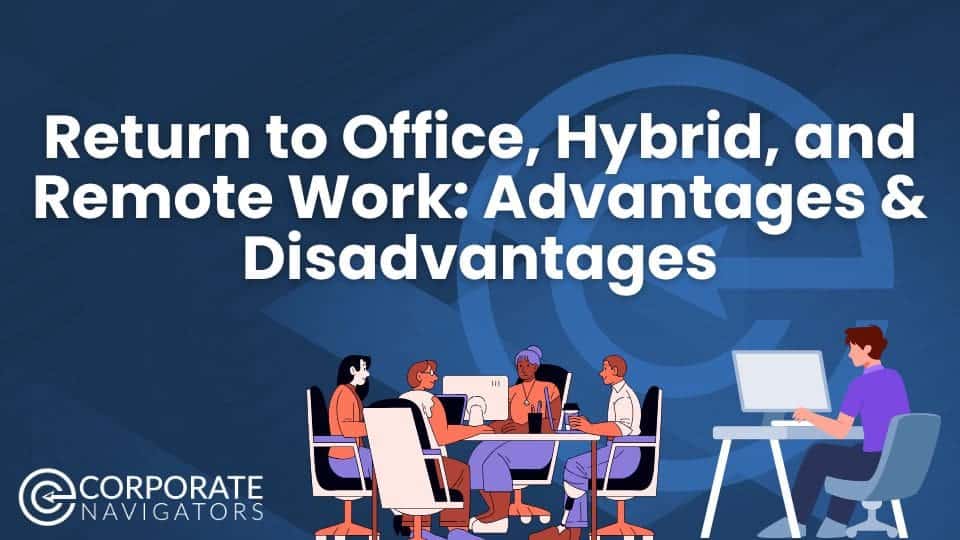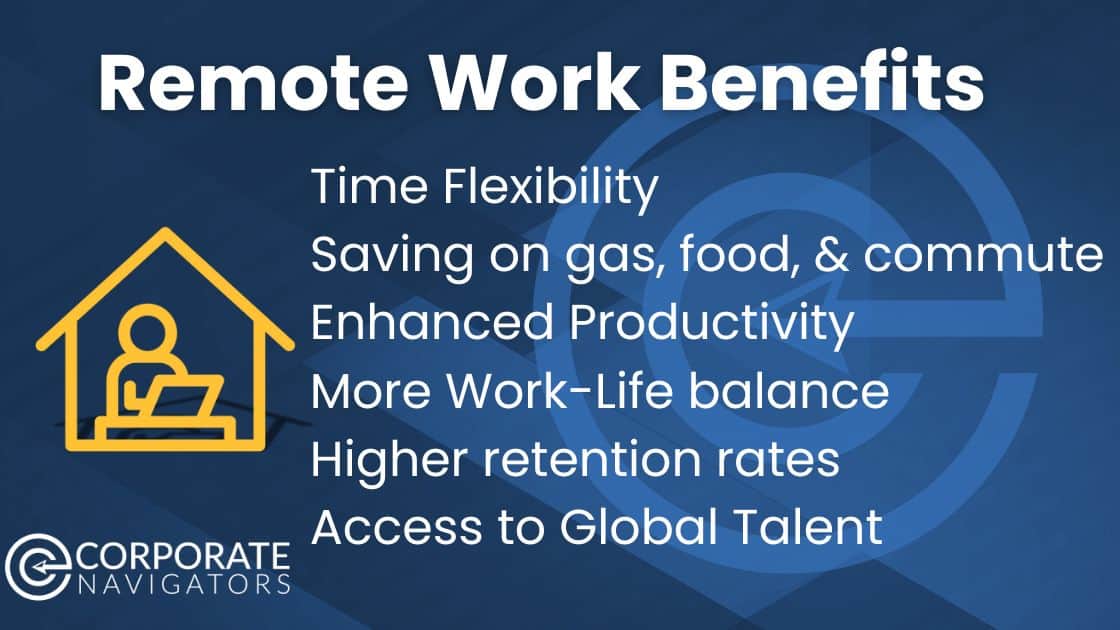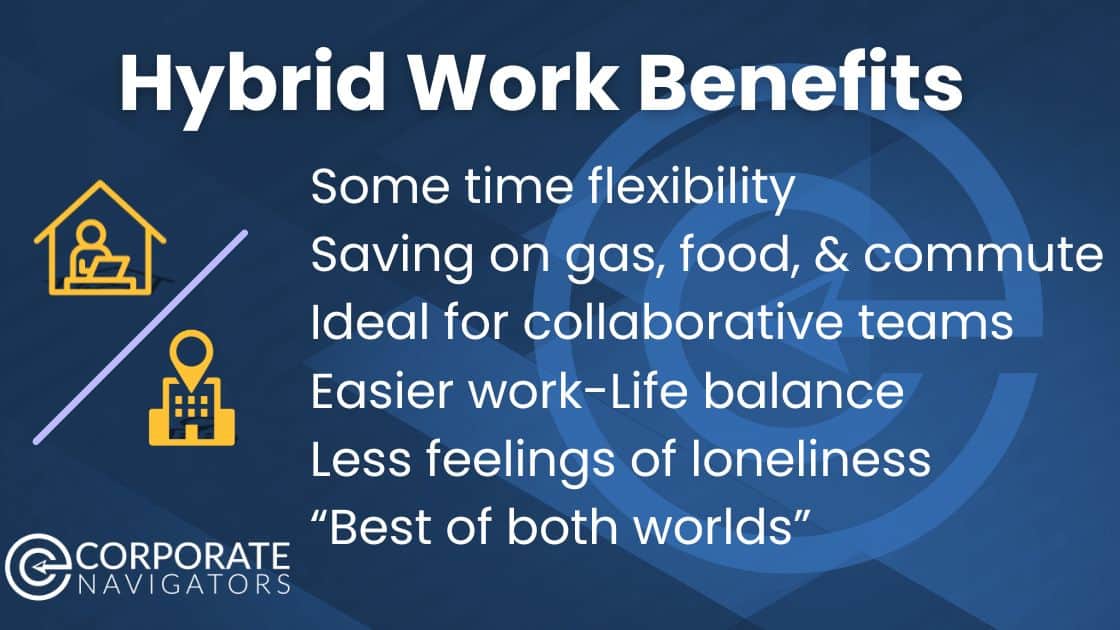
Table of Contents
RTO, Hybrid, or Remote: Which is best for you?
With big companies like Amazon calling for return to office 5 days a week, this begs the question, why, and what are the benefits of the full in person model, hybrid work, or full remote?
When considering work arrangements, full-time in-office (RTO), hybrid, and virtual models each offer distinct advantages and challenges that can impact both employees and organizations. What are they and which model is right for your workplace? Corporate Navigators answers some typical questions regarding these work models so you can decide what is the best for your line of work.
Each Work Model at a Glance
Full-Time In-Office (RTO)
This traditional model has employees in the office five days a week from 9-5. This model is necessary when the business thrives with direct, in-person collaboration, immediate communication, and a strong sense of company culture.
Employees can benefit from face-to-face interactions, which enhances team bonding and facilitate mentorship opportunities. However, this arrangement may limit time flexibility, adding in long commutes, making it harder for employees to balance personal commitments like doctors appointments, childcare, elder care, which could lead to increased stress compared to more flex models.
Hybrid Model
The hybrid approach combines elements of both in-office and remote work, which often includes three days in office and two remote days. Employees can split their time between the office and home, allowing for flexibility while still maintaining some in-person collaboration.
This model can improve work-life balance and job satisfaction, as employees can work remotely and have more flexible work hours to take care of needs like doctors appointments or childcare pickup without needing to take off work. However, this model requires everyone to be on board with making the most of in-person days for collaborative tasks and learn to work independently in the home office environment.
Remote Work
Made popular during the pandemic, fully remote work offers maximum flexibility, allowing employees to work from anywhere five days a week. This can lead to increased productivity and satisfaction, but also requires regular touch points to ensure collaboration.
This model can also reduce overhead costs for companies and broaden the talent pool by eliminating geographic constraints. However, it may pose challenges in terms of team cohesion, communication, and the potential for employees to feel isolated without regular in-person interaction. Regular meetings are a must with fully remote teams, as well as organized task lists and communication platforms like Slack.

Which Model is Best for Your Workplace?
Every company has different collaborative needs, making work models no one-size-fits-all deal. If you are finding that your current setup is making employees unhappy or less productive, it may be time to explore alternative options. You don’t have to make drastic changes either. For example, offering fully in-office workers a set number of remote days or flex hours that they can use throughout the year can make life infinitely more manageable.
Talk to your leaders and teammates and check how happy and productive they are with their current work setup. From this data, you can try new work schedules or models to best fit the needs of your evolving workforce.
What are the benefits of in-person, hybrid, and remote work models?
Return to Office Benefits
In-office work models offer a variety of benefits for employees and organizations alike. While hybrid and remote work models have gained popularity in recent years, there are still several advantages to the traditional in-office model. These include enhanced collaboration and communication between team members in real time, enabling strong bonds and faster decision making. This also grants easier access to mentoring from more experienced leaders, stimulating professional growth.
In addition, in-office workers have clear, distinct boundaries between work and personal life. Whereas hybrid and remote work can unintentionally make work bleed into after hours and weekends due to the lack of distinction between work and home, doing work strictly in an office can help a worker “switch on” and “off” work mode.
Also, there are quite a few jobs in which having access to specialized machinery and office equipment is necessary to do the job correctly. Having an office with everything set up and available is crucial to operations, which also facilitates on-the-job learning, especially if training with this equipment is part of in-person mentoring and training programs.

Hybrid Work Model Benefits
The hybrid work model brings in the benefits of remote and in-person work into a balanced work model that offers more flexibility for work-life balance. This model offers an in-office environment with mandatory in-office days with remote days also available. This flexibility helps them balance personal and professional responsibilities more effectively. Therefore, employees can adjust their schedules to accommodate family commitments, personal interests, or other obligations, leading to higher job satisfaction.
Cost savings is also a benefit for employees and business owners. By avoiding daily commutes, employees save time and money, which contributes to lower stress levels and better overall well-being. It can also reduce the need for some office space, cutting spend on commercial real estate and allowing companies to allocate more of their budget to other needs.
This model is great for jobs that require some collaboration but not daily collaboration. By combining in-person teamwork with remote communication, hybrid work fosters connection while still offering flexibility. It is also ideal for people who enjoy working independently some days while also filling their social cup on in-person days, reducing feelings of loneliness that can be associated with fully remote work.
Remote Work Model Benefits
One of the most significant advantages of remote work is maximum time flexibility followed by cost savings on the part of the employee and employer. Employees have the freedom to choose their work hours and environment, which allows them to better manage personal commitments and maintain a healthy work-life balance. This flexibility often leads to higher job satisfaction, as employees can tailor their schedules to fit their needs. It’s great for caregivers and people who have challenges with daily commutes.
Many remote workers report enhanced productivity due to fewer office distractions (like those water cooler chats) and the ability to create a personalized workspace to their distinct tastes. They can also focus on their well-being the most out of the three work models since they can more easily make time for exercise and wellness visits to the doctor.
Unlike in-person or hybrid work, remote work enables organizations to access a global talent pool, broadening a company’s recruitment options and allowing them to find the best candidates regardless of location. This can lead to improved employee retention, ultimately reducing turnover rates and associated hiring costs.
Return to Office, Hybrid, or Remote?
In conclusion, each work model—whether full-time in-office, hybrid, or remote—offers distinct benefits that cater to different needs and preferences. The traditional full-time in-office model fosters enhanced collaboration, mentorship, and clear boundaries between work and personal life, making it ideal for roles that require consistent team interaction and specialized equipment. The hybrid model strikes a balance by offering flexibility and promoting a healthy work-life balance, while still maintaining in-person collaboration and access to company culture.
Lastly, the remote model provides the ultimate flexibility, enabling employees to manage their time and environment in ways that maximize productivity and job satisfaction. Ultimately, the best work model depends on a company’s specific goals, workforce needs, and the nature of the work being done. Companies can thrive by staying flexible and continuously assessing employee satisfaction and productivity to find the most effective work structure for their evolving needs.



